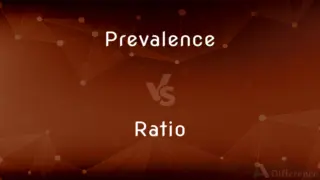Phial vs. Vial — What's the Difference?
By Tayyaba Rehman & Fiza Rafique — Updated on March 27, 2024
Phials and vials are both small bottles, typically used to hold liquids, but "vial" is more common in modern usage.

Difference Between Phial and Vial
Table of Contents
ADVERTISEMENT
Key Differences
Phials and vials refer to small glass or plastic containers used to store liquids, often for medicinal or scientific purposes. While both terms are sometimes used interchangeably, "vial" is the term more commonly used in contemporary contexts, especially in the fields of medicine and science.
Phials have a historical connotation and are less commonly used in everyday language. They are often associated with older texts or more poetic uses, referring to small containers that could hold potions or elixirs. Vials, on the other hand, are widely used in modern medical practices, laboratories, and pharmaceutical settings, emphasizing their practical application in storing samples, vaccines, or medications.
The shape of phials and vials can vary, but they typically have a narrow opening and are designed for secure storage of liquid contents. Phials may sometimes be perceived as having a more archaic or mystical quality due to their association with alchemy and ancient medicine. Meanwhile, vials are often designed with specific uses in mind, such as the storage of injectable medication, and may come with features like screw caps or rubber stoppers for needle access.
The choice between the terms phial and vial can also reflect regional preferences or traditional practices in certain fields. In some contexts, phial might be used for its aesthetic or historical implications, whereas vial is preferred for its clarity and modern relevance.
Despite these nuances, in practical terms, the difference between phials and vials is largely semantic. The key consideration for both is their function as containers for small quantities of liquid, designed to preserve the integrity and purity of the contents.
ADVERTISEMENT
Comparison Chart
Usage
Historically common, now less used.
More commonly used in modern language, especially in science.
Connotation
Often associated with older or more poetic contexts.
Associated with practical and medical applications.
Common Fields
Alchemy, ancient medicine, perfumery.
Pharmaceuticals, laboratories, medical fields.
Design
Small, typically glass, with a narrow opening.
Can be glass or plastic, often with secure sealing features.
Regional Use
May be preferred in certain literary or historical contexts.
Widely recognized and used globally in professional settings.
Compare with Definitions
Phial
A small glass container, historically used to hold liquids like potions.
The ancient apothecary stored remedies in glass phials.
Vial
A small container used for storing liquid medicines, especially in pharmacies.
The nurse prepared the injection from a small vial.
Phial
A vessel for liquids, often used in alchemical and historical contexts.
He carefully labeled each phial with its contents.
Vial
A glass or plastic tube with a closure, used in medical and scientific settings.
The lab technician filled vials with samples for testing.
Phial
A container used for holding sacred or magical liquids.
The phial contained water from the sacred spring.
Vial
A container for samples or chemicals, often used in experiments.
Each vial was labeled with the date and contents.
Phial
A term used in literature and historical texts to refer to small bottles.
The manuscript described an elixir kept in a crystal phial.
Vial
A term denoting practicality and modern usage in pharmaceuticals.
The vaccine doses were carefully stored in vials.
Phial
An archaic term for a vial, especially in poetic or mystical narratives.
The witch brewed the potion and poured it into a phial.
Vial
A small bottle designed for secure storage of liquids, with features like screw caps.
The vial's rubber stopper was designed for needle access.
Phial
A vial.
Vial
A vial (also known as a phial or flacon) is a small glass or plastic vessel or bottle, often used to store medication as liquids, powders or capsules. They can also be used as scientific sample vessels; for instance, in autosampler devices in analytical chromatography.
Phial
A glass vessel or bottle, especially a small bottle for medicines.
Vial
A small container, usually with a closure, used especially for liquids.
Phial
(transitive) To put or keep in, or as in, a phial.
Vial
To put or keep in or as if in a vial.
Phial
A glass vessel or bottle, especially a small bottle for medicines; a vial.
Vial
A glass vessel or bottle, especially a small tube-shaped bottle used to store medicine, perfume or other chemicals.
Phial
To put or keep in, or as in, a phial.
Its phial'd wrath may fate exhaust.
Vial
(transitive) To put or keep in, or as in, a vial.
Phial
A small bottle that contains a drug (especially a sealed sterile container for injection by needle)
Vial
A small bottle, usually of glass; a little glass vessel with a narrow aperture intended to be closed with a stopper; as, a vial of medicine.
Take thou this vial, being then in bed,And this distilled liquor drink thou off.
Vial
To put in a vial or vials.
Vial
A small bottle that contains a drug (especially a sealed sterile container for injection by needle)
Common Curiosities
Why might someone use the term "phial" instead of "vial"?
The term "phial" might be used for its historical or aesthetic connotations, particularly in literature or contexts evoking a sense of antiquity.
What are common uses for vials?
Vials are commonly used in the medical field for storing medications, vaccines, and samples for laboratory testing.
What is a vial?
A vial is a small container, typically made of glass or plastic, used in modern settings to store liquids, especially medicines.
What is a phial?
A phial is a small glass container, historically used to hold liquids, often with connotations of alchemy or ancient medicine.
How are vials sealed?
Vials are often sealed with screw caps or rubber stoppers to ensure the contents remain sterile and uncontaminated.
Are phials and vials interchangeable?
While functionally similar, the term "phial" is more historical or literary, whereas "vial" is preferred in contemporary, especially medical, contexts.
Can vials be made of materials other than glass?
Yes, vials can also be made of plastic, especially for medical applications requiring sterilization or disposability.
How important is the choice between "phial" and "vial" in professional settings?
In professional settings, especially in science and medicine, "vial" is the preferred term due to its clarity and modern relevance.
Where are phials typically found today?
Phials are more likely to be found in historical collections, museums, or used in literature rather than in practical, everyday settings.
What role do vials play in healthcare?
Vials are essential in healthcare for the safe storage and handling of medications, vaccines, and samples, ensuring dosage accuracy and sterility.
Is there a difference in the shape between phials and vials?
Both can vary in shape, but the primary function as a container for liquids is consistent, with specific designs suited to their use.
What is the significance of using plastic for vials?
Plastic is often used for vials in medical settings for its durability, ease of sterilization, and disposability, enhancing safety and convenience.
Are there any regulations regarding the use of vials?
Yes, there are strict regulations regarding the manufacture, labeling, and use of vials in healthcare and laboratory settings to ensure safety and efficacy.
Do phials have any specific features?
Phials, like vials, have a narrow opening, but they are more often associated with historical designs or materials, like blown glass.
Can vials be reused?
Depending on the material and the use case, some laboratory vials can be sterilized and reused, while medical vials are usually single-use.
Share Your Discovery

Previous Comparison
Digitigrade vs. Plantigrade
Next Comparison
Prevalence vs. RatioAuthor Spotlight
Written by
Tayyaba RehmanTayyaba Rehman is a distinguished writer, currently serving as a primary contributor to askdifference.com. As a researcher in semantics and etymology, Tayyaba's passion for the complexity of languages and their distinctions has found a perfect home on the platform. Tayyaba delves into the intricacies of language, distinguishing between commonly confused words and phrases, thereby providing clarity for readers worldwide.
Co-written by
Fiza RafiqueFiza Rafique is a skilled content writer at AskDifference.com, where she meticulously refines and enhances written pieces. Drawing from her vast editorial expertise, Fiza ensures clarity, accuracy, and precision in every article. Passionate about language, she continually seeks to elevate the quality of content for readers worldwide.












































